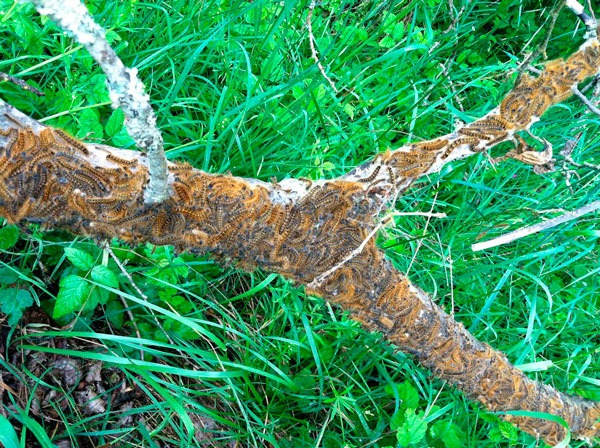By Michele Mangiantini
A common first reaction to leaf-eating evidence that offers a common answer: insect defoliators.
Our region has many kinds of insect defoliators, named and categorized as case makers, crumplers, folders, gall makers, leaf rollers, miners, shot-hole makers, skeletonizers, tent makers, tiers, tip-tiers, twirlers, twisters and web makers.
We have several native species of defoliators here but a growing number are exotic and new to our area, making it difficult to determine just exactly which one is causing the damage.
Understanding the lifecycle of these insects will assist in identifying the species and deciding what to do, if anything, to control them.
These leaf-eating insects have four basic life stages. Defoliators’ biology generally begins as eggs are laid on or near leaves of the host plant. As eggs hatch into larva, the caterpillars begin to feed on the leaves. This feeding that continues for about two weeks is when most of the defoliation damage is done.
As smaller larva, most caterpillars have light green bodies with darker heads that eventually grow into more patterns and color details, making them slightly easier to identify than their adult counterpart.
At the end of larval development they begin to build shelters in the leaves. They will crumple, fold, roll, twist, or whatever they do, creating a cocoon or chrysalis to protect themselves against predators and parasitoids.
While in these leafy structures, the pupal stage lasts for two to three weeks, after which they emerge as adults. Very few species of adult moths feed, instead they will drink water and flower nectar, mate and then repeat the cycle.
Most defoliators complete one lifecycle annually, yet a few create more than one generation per year.
Defoliating insects are an important food source for wildlife; especially vital during spring when birds are nesting and caterpillars are at large for nurturing the young.
On the bright side …
Fortunately, defoliation in our area is seldom a cause for concern. Natural predators and parasitoids are equally numerous for these insects and migration also can occur to lessen future outbreaks.
Controls in your home garden may only require occasional hand-picking of defoliators as eggs, caterpillars, cocoons or moths are found.
Although plant defoliation rarely causes permanent injury to the host plants, the unsightly damage that occurs during the spring is visible throughout the remainder of the year.
Reaction by consumers to this insect destruction is the most common cause of pesticide use.
In order to chemically control them, treatment must be applied at the larval stage, while they are feeding, or the efforts will be useless. The chemicals used to control these insects also are harmful to the predators and parasitoids that control them naturally and should be avoided.
For additional information and help identifying the species you are dealing with, visit PNW Defoliators at http://invasives.wsu.edu/defoliators/.
Or bring a sample of the insect and include any examples of the damage or evidence to a Clallam County Master Gardener Plant Clinic held from 9 a.m.-1 p.m. Mondays at the courthouse in Port Angeles or on Saturdays at the MG Demonstration Garden at 2711 Woodcock Road in Sequim.
Reach the Plant Clinic Helpline at 417-2514.
Michele Mangiantini is a Washington State University-certified, Clallam County Master Gardener.



